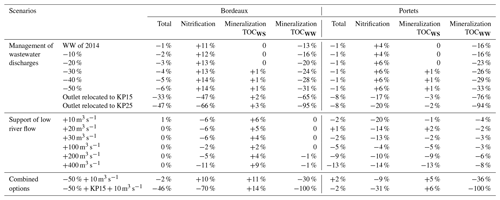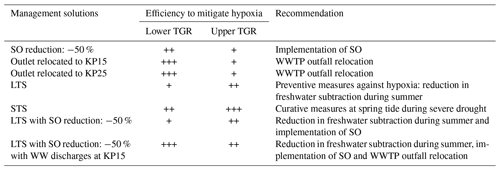the Creative Commons Attribution 4.0 License.
the Creative Commons Attribution 4.0 License.
Comparing the efficiency of hypoxia mitigation strategies in an urban, turbid tidal river via a coupled hydro-sedimentary–biogeochemical model
Katixa Lajaunie-Salla
Aldo Sottolichio
Sabine Schmidt
Xavier Litrico
Guillaume Binet
Gwenaël Abril
Coastal-water hypoxia is increasing globally due to global warming and
urbanization, and the need to define management solutions to improve the
water quality of coastal ecosystems has become important. The lower tidal
Garonne River (TGR; southwestern France), characterized by the seasonal
presence of a turbidity maximum zone (TMZ) and urban water discharge, is
subject to episodic hypoxia events during low river flow periods in the
summer. Future climatic conditions (higher temperature and summer droughts) and
increasing urbanization could enhance hypoxia risks near the city of
Bordeaux in the coming decades. A 3-D model of dissolved oxygen (DO) that
couples hydrodynamics, sediment transport and biogeochemical processes was
used to assess the efficiency of different management solutions for
oxygenation of the TGR during summer low-discharge periods. We ran different
scenarios of reductions in urban sewage overflows, displacement of urban
discharges downstream from Bordeaux and/or temporary river flow support
during the summer period. The model shows that each option mitigates hypoxia,
but with variable efficiency over time and space. Sewage overflow reduction
improves DO levels only locally near the city of Bordeaux. Downstream
relocation of wastewater discharges allows for better oxygenation levels in
the lower TGR. The support of low river flow limits the upstream TMZ
propagation and dilutes the TGR water with well-oxygenated river water.
Scenarios combining wastewater network management and low-water
replenishment indicate an improvement in water quality over the entire TGR.
These modelling outcomes constitute important tools for local water
authorities to develop the most appropriate strategies to limit hypoxia in
the TGR.
Highlights.
-
A 3-D model shows different efficiencies of management actions to limit hypoxia.
-
Downstream relocation of wastewater discharge totally mitigates hypoxia.
-
Sewage overflow reduction improves DO levels but only locally.
-
Water replenishment improves DO in the upper estuary.
Hypoxia refers to low dissolved-oxygen (DO) conditions when concentrations fall below 2 mg L−1 (or <30 %) of saturation. This is a major environmental issue, as it stresses marine organisms and disturbs the function of the marine ecosystem (Rabalais et al., 2010; Vaquer-Sunyer and Duarte, 2008). Coastal hypoxia is a widespread phenomenon that has increased since the middle of the 20th century due to the combined effects of climate change and local anthropic activities (land and water uses; Breitburg et al., 2018). Good oxygenation of estuarine water is crucial in order to maintain ecological and economical services within the whole watershed because of the strategic position of estuaries for migratory fishes (Rabalais et al., 2010). Estuarine deoxygenation is the result of a complex interaction of environmental factors. First, an increase in temperature decreases the oxygen solubility of the water, favours thermal stratification of the water column, limiting reaeration (Conley et al., 2009; Lehmann et al., 2014), and accelerates DO-consuming biogeochemical processes (Goosen et al., 1999). Second, a decrease in river flow modifies estuarine residual circulation, sediment transport, and the transit and mineralization of terrestrial organic material in estuaries (Abril et al., 1999; Howarth et al., 2000). In addition, an increase in population and human activities enriches coastal water with nutrients and labile organic matter from urban effluents, possibly leading to eutrophication (Billen et al., 2001). Finally, in macrotidal estuaries, DO consumption by heterotrophic organisms is exacerbated by the presence of a turbidity maximum zone (TMZ), which favours the growth of particle-attached bacteria and, in contrast, limits phytoplankton primary production (Diaz, 2001; Goosen et al., 1999; Talke et al., 2009). In view of the ongoing global changes, it is now essential to find management strategies for hypoxia mitigation. Recovering or maintaining a good ecological status for transitional water is one of the objectives of the European Water Framework Directive (Best et al., 2007).
In an urban tidal river, the first obvious action to mitigate hypoxia is to improve the urban wastewater network and treatment and to reduce the input of organic matter and nutrients to the estuary. In several European estuaries suffering from urban input, water quality improvement was achieved by the installation and renovation of a wastewater treatment plant (WWTP) in the Thames Estuary in the 1980s (Andrews and Rickard, 1980; Tinsley, 1998) and the construction of a WWTP in the Seine River in the 1990s (Billen et al., 2001). In the Scheldt Estuary, sewage network improvement reduced N, P and Si loads by 5.4 %, 1.3 % and 1 %, respectively, and two WWTPs have been implemented for the city of Brussels since 2000 (Billen et al., 2005; Soetaert et al., 2006; Vanderborght et al., 2007). Sewage network systems in Europe usually combine both urban sewage and stormwater collection. During heavy rain and storm events, the capacity of the urban wastewater network is generally insufficient for treating all effluents, inducing deoxygenation events due to untreated wastewater release from sewage overflow (SO; Even et al., 2007). In the 2000s, the Environmental Protection Agency promoted a strategy to monitor urban drainage networks in real time to regulate flow and avoid the overflow of untreated wastewater (EPA, 2006; Gonwa and Novotny, 1993). This control was developed in several cities in the USA (Gonwa and Novotny, 1993) as well as in Québec (Pleau et al., 2005) and Tokyo (Maeda et al., 2005). An additional management solution was tested in the Thames Estuary: the construction of a 24 km long sewer network under the riverbed that allows the transit of urban wastewater to the WWTP located downstream (Thames Tideway Tunnel: https://www.tideway.london/, last access: 14 November 2019). This type of solution is also ongoing in Stockholm (https://www.stockholmvattenochavfall.se/, last access: 14 November 2019) and in the Helsinki (https://www.hsy.fi, last access: 14 November 2019) metropolis.
In macrotidal estuaries, the lowest DO concentrations occur during the lowest river flow (Lanoux et al., 2013; Talke et al., 2009; Zhang et al., 2015). A second possible action could therefore be to modify river discharges and to reduce water flushing time to promote the dilution by well-oxygenated water and/or the seaward dispersion of oxygen-consuming matter (Lajaunie-Salla et al., 2018). This implies providing water replenishment above critical levels by limiting water abstraction for irrigation in the watershed or by modulating water release from dams when hypoxia is present (Schmidt et al., 2017).
To optimize preventive management strategy, the efficiency of the potential solutions needs to be evaluated. Therefore, numerical modelling is an efficient tool to quantitatively assess hypoxia mitigation by management scenarios. Moreover, models provide guidelines for setting objectives to maintain good water quality in coastal environments (Kemp et al., 2009; Skerratt et al., 2013).
A recently developed 3-D coupled hydro-sedimentary–biogeochemical DO model simulated possible scenarios for the coming decades, suggesting a future spatial and temporal extension of summer hypoxia in the tidal Garonne River (TGR; SW France), an urban, turbid tidal river (Lajaunie-Salla et al., 2018). Until now in the TGR, only a few hypoxia events have been reported, for example, during summer 2006 (Lanoux et al., 2013). Previous work highlighted that these low DO levels are due to the combination of the presence of the TMZ, high water temperature, drought periods and urban effluent input (Lajaunie-Salla et al., 2017; Lanoux et al., 2013; Schmidt et al., 2017). Such a perspective of permanent summer hypoxia in the lower TGR implies the need to develop management strategies to protect the ecosystem. The aim of the present work was to assess the efficiency of possible management solutions to limit future hypoxia risk in the tidal Garonne River. For this purpose, we applied the aforementioned DO model in order to simulate scenarios based on two main management actions: optimization of the urban wastewater network and freshwater replenishment during low-water periods.
2.1 Study area
The Garonne River, located in southwestern France, is the main tributary of the Gironde Estuary, which is formed by its confluence with the Dordogne River and flows toward the Atlantic Ocean (Fig. 1). This macrotidal fluvio-estuarine system is characterized by the presence of a TMZ, where suspended sediment concentrations in surface water are >1 g L−1 (Allen, 1972). The position of the TMZ varies seasonally: during low river flow, it is present in the tidal Garonne River from KP25 to KP70, i.e. upstream of Pauillac (Fig. 1). The rest of the year, the TMZ is located near Pauillac (Fig. 1), in the Gironde Estuary (Jalón-Rojas et al., 2015).
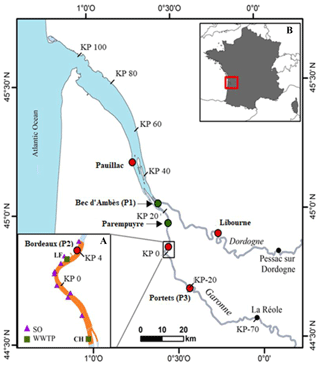
Figure 1The Gironde–Garonne–Dordogne estuary, including the tidal Garonne River in southwestern France (Inset B). “KP” denotes the distances in kilometres from the city centre of Bordeaux; the control grid cell at Bordeaux is at KP4, and Portets is at KP20. Inset A indicates position of the sewage overflows (purple triangles) and of the two wastewater treatment plants (green squares). The area in orange represents the area of Bordeaux for which the biogeochemical fluxes were calculated.
The annual mean Garonne River flow is 680 m3 s−1 for the period 1913–2018, with the highest flows in winter (mean of 720 m3 s−1) and the lowest flows in summer and early autumn (mean of 190 m3 s−1; http://www.hydro.eaufrance.fr/indexd.php, last access: 2014). The threshold of 110 m3 s−1 is the present-day low-water target flow for the lower Garonne, below which there is water replenishment for the period from 1 June to 31 October. Over the last decades, a decrease in the Garonne River flow was not only observed due to changes in precipitation but also due to the water abstraction for hydroelectric dams and irrigation (Schmidt et al., 2017). This is associated with an increase in the number of days the river flow is below 110 m3 s−1: an average of 26.9 d yr−1 for the period 2008–2018 compared to 1.4 d yr−1 for the period 1975–1985 (http://www.hydro.eaufrance.fr/indexd.php). Such a decrease in the Garonne flow limits the reoxygenation of the TGR water with well-oxygenated freshwater and favours upstream advection and the concentration of the TMZ (Lajaunie-Salla et al., 2018). Six water reservoirs that can store a maximum water volume of 58 hm3 are located in the upper Garonne River, corresponding to an equivalent river flow of 95 m3 s−1 during a single week. This water storage is used to maintain the Garonne discharge above the critical threshold of 110 m3 s−1 for the ecosystem during the summer.
The large city of Bordeaux is located at the border of the tidal Garonne River, 25 km upstream of the confluence (Bec d'Ambès; Fig. 1). The sewage system of the metropolis drains an urban area of 578 km2 and serves a population estimated at 749 595 inhabitants in 2015. Part of the sewage system is composed of a combined sewer network: two wastewater treatment plants, Clos de Hilde and Louis Fargue, and nine sewage overflows. The release of treated and untreated wastewater represents up to 1.5 % of the fluvial Garonne discharge (Lanoux et al., 2013).
The Bordeaux metropolis has already taken several actions to improve the urban wastewater network. In 2011, the WWTP Louis Fargue was resized and upgraded to the treatment effectiveness of the WWTP Clos de Hilde. In addition, since 2013, real-time control of the urban drainage network was developed to reduce urban effluents during rainy weather (Andréa et al., 2013). This system decreased the volume of untreated wastewater released by 30 % in 2013 and by 40 % in 2014 and 2015 (Robitaille et al., 2016), improving the overall net purification efficiency to >95 % for particulate organic carbon (POC), >75 % for dissolved organic carbon (DOC) and >30 % for ammonia (Lanoux, 2013).
2.2 Model description
The SiAM-3D model, which couples hydrodynamics, suspended sediment transport and biogeochemical processes (Lajaunie-Salla et al., 2017), was used to test the efficiency of possible management solutions. The model was implemented for the Gironde Estuary from the 200 m isobath on the continental shelf to the upstream limits of the tidal propagation on both rivers (Sottolichio et al., 2000). The mesh of the model is an irregular grid, with a finer resolution in the estuary (200 m × 1 km) and coarser resolution on the shelf. The tidal rivers are represented by one cell in width. The vertical grid uses real depth coordinates and is split into 12 layers. The model uses a finite-difference numerical scheme with a transport time step of 35 s.
The transport model solves the advection–dispersion equations for dissolved and particulate variables, i.e. suspended sediment, salinity and biogeochemical variables. The biogeochemical model extensively resolves the processes that produce and consume oxygen in the water column, taking different types of dissolved and particulate organic matter into account: degradation of organic matter (mineralization of organic carbon and ammonification using the C∕N ratio); nitrification; photosynthesis, respiration and mortality of phytoplankton; and DO gas exchange with the atmosphere. The model includes 11 state variables: DO, ammonia (; input from rivers and mainly from urban effluents), nitrate (), POC and DOC from the watershed (POC from litter; DOC from rivers), WWTPs, SO, phytoplankton, and detritus. At the open boundaries, the hydrodynamic model is forced by astronomical tides at the shelf and by daily river flow of the Garonne and Dordogne rivers at the upstream limit (data from http://www.hydro.eaufrance.fr/indexd.php). The biogeochemical model uses measured water temperature from Bordeaux station (MAGEST network; Etcheber et al., 2011; http://magest.oasu.u-bordeaux.fr/, last access: 14 November 2019) and wind and incident light intensity from the Pauillac station (Météo-France). The boundary conditions of biogeochemical variables were detailed by Lajaunie-Salla et al. (2017), and the data of organic matter and nutrients were retrieved from the works of Etcheber et al. (2007), Lemaire (2002), Lemaire et al. (2002) and Veyssy (1998). Urban wastewater discharges are included in the model with biodegradable POC and DOC and NH4 loads representative of water flowing from WWTP and from SO. Values are updated every 5 min, concentration data are from Lanoux (2013), and flow data are from the WWTP.
The model was compared with data available for the TGR and tested on the basis of three criteria: (i) the ability to reproduce the observed DO variability at a seasonal scale, (ii) the ability to reproduce the spring-neap tidal cycle and (iii) a statistical evaluation based on the Willmott skill score (WSS; Willmott, 1982). In brief, the model performed well (WSS >0.7) in the lower TGR around Bordeaux and is less accurate in the upper section (WSS <0.5); the model and its validation are presented in detail by Lajaunie-Salla et al. (2017).
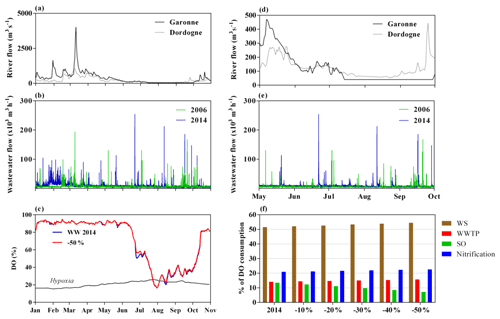
Figure 2Time series of Garonne River (black) and Dordogne River (grey) flow of the reference simulation (a, d; m3 s−1), and wastewater discharges (WWTP ± SO) for 2006 (green) and 2014 (blue) (b, e; m3 s−1): panels (a) and (b) present the whole simulation period from January to October, and panels (d) and (e) present a zoomed view from May to October. Comparison of simulated DOmin evolution (over tidal cycle in % saturation) in Bordeaux with urban effluents of 2014 (blue) and with a 50 % reduction in SO (red) (c). The contribution to DO consumption (%) of degradation of watershed organic matter (brown), WWTP (red), SO (green) and nitrification (blue) in Bordeaux (f). For nitrification processes, ammonium comes from watershed and wastewater.
In this work, we want to demonstrate the advantage and/or effectiveness of urban water networks and treatment processes for limiting hypoxia events during critical conditions. The reference simulation is based on the real conditions of 2006, which was a critical year from the point of view of river discharge, temperature and hypoxia. A 21 d heat wave occurred, and the summer water temperature reached a maximum of 29.5 ∘C, with an average of 24.6 ∘C. However, the reference simulation was run with an even more severe and constant low flow of 40 m3 s−1 from 15 July to 30 September. This flow is different from the real river flow recorded in 2006 (75 vs. 60 continuous days of river flow below 110 m3 s−1, respectively) in order to better visualize the impact of potential management solutions on oxygenation (Fig. 2a). In addition, to produce more realistic simulation of treated and untreated wastewater discharges, we used the WWTP flow of 2014, a year presenting similar volumes to 2006, to run the reference simulation. Indeed, the sewage network of the Bordeaux metropolis was improved in 2011, inducing a reduction of the contribution of SO to the total urban discharges from 16 % in 2006 to 12 % in 2014.
2.3 The scenarios
Several scenarios have been designed to assess the efficiency of the retained management strategies to improve the DO levels of the tidal Garonne River (Table 1): optimization of the urban wastewater network and water replenishment during low-water periods.
Table 1Forcing of the different scenarios simulated with the model (Qref: river flow of 2006; QG∕D: river flow of Garonne and Dordogne; QWW: wastewater flow; SO: sewage overflow).
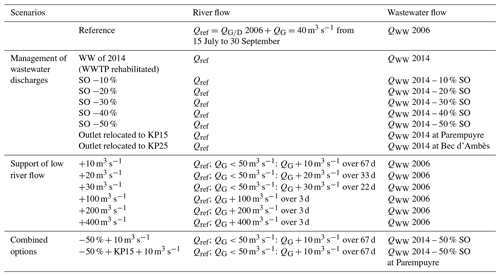
Table 2Minimum simulated DO (in % saturation and in mg L−1), the corresponding temperature, and the number of hypoxia days in Bordeaux and Portets for each scenario. (WW: wastewater).
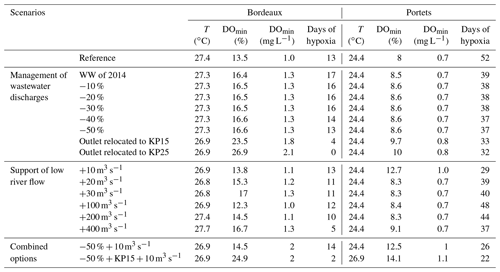
Two main actions of wastewater management were simulated (Table 2).
-
The increase in wastewater storage during storms. For this, fractions of 10 %, 20 %, 30 %, 40 % and 50 % of untreated wastewater SO were transferred to WWTP discharges (taking the organic matter and nutrient loads of WWTP into account). In comparison with the reference simulation, an improvement of 50 % in WW treatment corresponds to a reduction of 26 % of POC and to an increase of 3 % DOC and of 6 % in NH4 loads.
-
The implementation of an outfall that releases urban effluents downstream. Two wastewater discharge points were tested: (1) at 21 km (same distance from WWTP as that in the Thames Estuary), corresponding to position KP25 (Fig. 1), where the currents are relatively high and could disperse urban effluents relatively quickly, and (2) at 11 km, corresponding to KP15 as an alternative and less expensive solution (Fig. 1). Although this solution seems difficult to implement due to technical and financial constraints, it is interesting to investigate its potential environmental benefits.
For the support of low river flow during the driest season, two actions were tested according to the maximum stored water volume in the dams (58 hm3) of the upper Garonne River (Table 2):
-
low-intensity and long-term support (LTS) from 15 July by 10, 20 and 30 m3 s−1 during 67, 33 and 22 d, respectively;
-
intense and short-term support (STS) as an emergency solution by 100, 200 and 400 m3 s−1 at spring tide from 27 to 29 July (3 d), corresponding to water volumes of 16, 41 and 93 hm3, respectively.
Finally, two scenarios that coupled wastewater management actions and the support of low river flow were simulated (Table 2).
-
LTS of 10 m3 s−1 over 67 d was combined with the reduction of 50 % of untreated wastewater SO, which is transferred to WWTP discharges.
-
LTS of 10 m3 s−1 over 67 d was combined with the reduction of 50 % of untreated wastewater SO, which is transferred to WWTP discharges and to the relocation of wastewater discharges 11 km (KP15) downstream of Bordeaux (Fig. 1).
The 16 scenarios were run over 10 months, from 1 January to 31 October. To evaluate the improvement of DO level, three indicators were used: (i) the minimum DO value (DOmin), (ii) the number of hypoxia days, i.e. DO <2 mg L−1, and (iii) the summer-averaged rates of biogeochemical processes consuming DO in the Bordeaux and Portets areas (6.6 and 1.2 km2 , respectively). The grid cells in front of Bordeaux and Portets were chosen because Bordeaux is directly under the impact of urban effluents and because Portets represents the presence of TMZ in the upper TGR.
3.1 Action 1: wastewater management
3.1.1 Action 1.1: reduction in sewage overflows
The simulations of sewage overflow reduction do not show an increase in DOmin at Bordeaux and Portets (Table 2). However, some short but significant differences in the modelled DO time series in Bordeaux are noticeable during the largest sewage overflow events (Fig. 2c). In fact, wastewater overflows represent, on average, 12 % of the urban effluents but could represent up to 98 % during storm events. For the scenario where SO is −50 %, there is a slight increase in DO level by 6 % saturation and 2 % saturation in late June and mid-August, respectively (Fig. 2c). The total DO consumption by biogeochemical processes decreases up to 6 % at Bordeaux (Table 3). The rate of mineralization of urban organic matter decreases considerably, by 31 % and 33 %, with a reduction of 50 % of SO flow at Bordeaux and Portets, respectively (Table 3). In fact, at Bordeaux, the material brought by the SO contributes 7 % of the total DO consumption, with a reduction of 50 % versus 13 % without reduction (Fig. 2d). In contrast, the nitrification process and degradation of treated urban effluents were slightly increased by the reduction in SO flow (Fig. 2d and Table 3). Indeed the wastewater transferred to WWTPs results, after treatment, in higher amounts of discharged ammonia than in effluents directly coming out from SO (Lanoux, 2013).
In these simulations, sudden wastewater release events from SO (late June) did not occur simultaneously with the maximum temperature (i.e. late July). In such a case, a more critical hypoxia event would have occurred. However, the modelling results show that the improvement of SO management contributes to improving the DO level only locally and temporarily in the vicinity of the city of Bordeaux.
3.1.2 Action 1.2: downstream relocation of wastewater discharges
In the case of a relocation of urban effluent discharge at KP15, only 4 d of hypoxia were simulated with a minimum of 1.8 mg L−1 (Table 2), which represents a reduction of 9 d in comparison with the reference simulation. In the case of the relocation of urban effluents discharge farther downstream at KP25, the model simulated no hypoxia and a minimum DO value of 2.1 mg L−1 (Table 2). The oxygen level in the vicinity of Bordeaux was improved. According to the model, Fig. 3 highlights that the displacement of the urban wastewater discharge point downstream significantly improves the oxygen levels in the TGR around Bordeaux and appears to be an efficient action to mitigate hypoxia near Bordeaux (Fig. 3). Moreover, the DO concentration does not change downstream of Bordeaux, maintaining a value of over 50 % saturation. Under these relocation scenarios, the amount of urban organic matter and ammonia are relatively low at Bordeaux. Urban effluents are diluted by downstream estuarine water and exported toward the Gironde. In fact, urban effluents reach the city of Pauillac, approximately 50 km downstream of Bordeaux (Fig. 1), after 1 and 1.5 d, when effluents are released at KP25 and KP15, respectively, versus after 2.5 d, when they are discharged near Bordeaux. With the downstream relocation of urban discharge, DO levels are strongly improved in the TGR without significantly altering the oxygenation condition downstream of Bordeaux. This phenomenon is due to shorter residence times of effluents and larger dilutions with oxygenated estuarine water downstream.
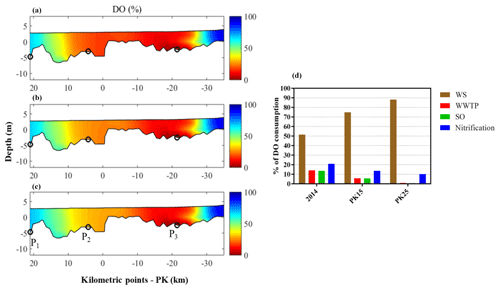
Figure 3Snapshot of the vertical transect of simulated DO saturation along the tidal Garonne river for the scenarios with urban effluent discharge points in Bordeaux (a), KP15 (b) and KP25 (c). P1, P2 and P3 indicate the locations of Bec d'Ambès, Bordeaux and Portets, respectively. The contribution to DO consumption (%) of degradation of watershed (brown), WWTP (red), SO (green) and nitrification (blue) processes at Bordeaux (d). For nitrification processes, ammonium comes from watershed and wastewater.
A downstream relocation (KP15 or KP25) significantly decreases total DO consumption in the lower TGR by 33 % and 47 %, respectively: the mineralization of urban matter is reduced by 65 % and 95 %, and the nitrification is reduced by 47 % and 69 %, respectively (Table 3). At Portets, even if the total DO consumption decreases only by 8 %, the degradation of urban matter decreases strongly by 76 % and 94 % and the nitrification is reduced by 17 % (KP15) and 20 % (KP25; Table 3). In fact, the mineralization of urban matter occurs downstream of TGR, with less impact on the DO in this area, thanks to the dilution effect with estuarine water. Finally, at Bordeaux, the contribution of urban effluents to the DO consumption decreases from 27 % to 2 %, and nitrification decreases from 20 % to 10 % (Fig. 3d).
The discharge of the wastewater downstream from the city centre considerably improves the water quality in the vicinity of Bordeaux. However, hypoxia persists in Portets (30 hypoxic days; Table 2 and Fig. 3) because in the upper TGR, hypoxia is mainly due to temperature, very high turbidity and low-water renewal.
3.2 Action 2: support of summer river discharge
3.2.1 Action 2.1: low-intensity and long-term support of summer river discharge
The simulations of low-intensity and long-term support of water flow show an increase in the DOmin not only at Portets but also at Bordeaux (Table 2). At Bordeaux, the DOmin increases by only 0.3 mg L−1, and the number of simulated hypoxia days decreases by only 2 d for a discharge increase of 30 m3 s−1. However, in Portets, oxygen levels are much more improved: the additional flow significantly reduces the number of hypoxic days, reducing them from 52 d (reference simulation) to 29, 39 or 40 d with support of 10, 20 or 30 m3 s−1, respectively (Table 2).
Significant effects of maintaining summer river discharge in the area of Bordeaux are reflected by the decrease in nitrification processes and the increase in mineralization of matter coming from the watershed (Table 3). At Portets, nitrification and mineralization of organic matter are decreased due to the diluted input of urban water upstream (Table 3).
These simulations show that low-intensity and long-term support of river flow considerably reduces hypoxia events in the upper TGR but not enough to significantly influence Bordeaux water. The average time to renew half of the water volume in Bordeaux is 22 and 67 d in the cases of river flows increased by 10 and 30 m3 s−1, respectively. By comparison, at Portets, the renewal times are only 3 and 11 d, respectively. The option of low-intensity support needs to be sufficiently long to maintain a good oxygen level all summer in the upper TGR. An additional river flow >10 m3 s−1 for 2 months would be a feasible solution to avoid hypoxia events upstream of Bordeaux, and freshwater storage should be optimized to reach these objectives.
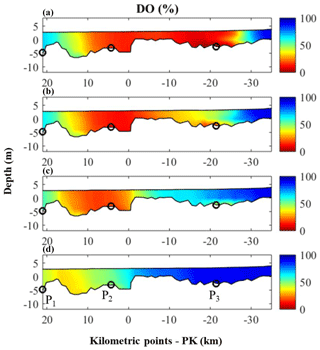
Figure 4Snapshot of the vertical transect of simulated DO concentration (in % saturation) along the tidal Garonne river for the scenarios of reference (a) and short river flow increases by 100 m3 s−1 (b), 200 m3 s−1 (c) and 400 m3 s−1 (d). P1, P2 and P3 indicate the locations of Bec d'Ambès, Bordeaux and Portets, respectively.
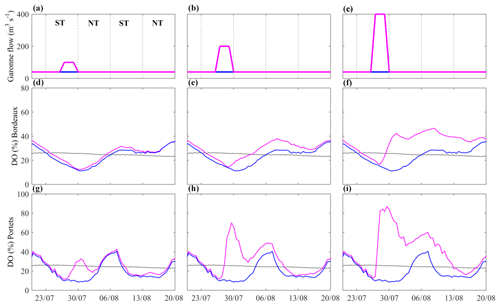
Figure 5Time series of river flow (a–c; m3 s−1), DOmin (over tidal cycle) at Bordeaux (d–f; % saturation) and DO at Portets (g–i; % saturation) for the scenarios of short river flow increases by 100 m3 s−1 (a, d, g), 200 m3 s−1 (b, e, h) and 400 m3 s−1 (c, f, i). The blue line represents the simulation of reference.
3.2.2 Action 2.2: intense and short-term support of low-water discharge
Intense and short-term support of freshwater allows low-oxygenated water to be pushed downstream and induces a strong dilution of estuarine water with well-oxygenated fluvial water due to the large amount of water supply (100, 200 and 400 m3 s−1; Figs. 4 and 5). Figure 4 highlights this phenomenon and the improvement of the oxygen level along the TGR, reaching the saturation level around Portets and a saturation higher than 50 % around Bordeaux (Fig. 4). The model results show decreases in the number of hypoxia days in Bordeaux and Portets (Table 2). The water half-renewal times are less than 1 d at Portets and decrease from 6.6 to 1.6 d at Bordeaux, with increasing discharge support from 100 to 400 m3 s−1. During short-term support, the DO concentrations increase faster at Portets than at Bordeaux (Figs. 4 and 5). During a semidiurnal tidal cycle, the DO rises by 9 % saturation at Bordeaux and by 56 % saturation at Portets, with an input of 400 m3 s−1. The higher the river flow support, the faster the water of the TGR is reoxygenated.
The total oxygen consumption decreases with STS only at Portets (Table 3). At Bordeaux, the decrease in nitrification is counterbalanced by an increase in river organic matter mineralization (Table 3). The intense short-term support moves the TMZ downstream to Portets, reducing organic matter mineralization in the area of Portets (Table 3 and Fig. 4).
The intense short-term support of freshwater (400 m3 s−1) is not able to maintain a good oxygen level all summer in Portets. After the massive water input, the DO level stayed above the hypoxia threshold for 17 d but then decreased again (Fig. 5i). This type of management is very powerful as an urgent remediation during severe hypoxia to quickly improve the oxygenation levels of TGR water, particularly in the upper section of the tidal river. For example, during the heat wave of the end July 2006 (Fig. 2c), STS would have prevented hypoxia. In the case of late hypoxia occurring at the end of the summer, STS may be efficient if the stored water volume is sufficient. Other scenarios of short-term support were made during neap tides (not shown) but were not very relevant because hypoxia events occur during spring tides (Etcheber et al., 2011; Lanoux et al., 2013; Lajaunie-Salla et al., 2017).
3.3 Synthesis of management actions efficiency
These different simulated scenarios allow us to quantitatively estimate the efficiency of different management options to reduce hypoxia in the TGR. The two management solutions have locally different impacts on DO (Table 4): optimization of the urban wastewater network reduces hypoxia in the lower TGR, whereas water replenishment during low-water periods enhances DO levels in the upper TGR. The improvement of the wastewater network by a reduction in labile organic matter input reduces oxygen consumption in Bordeaux water. The alternative, consisting of discharging urban effluents downstream of the lower TGR, has the advantage of diluting wastewater with the Gironde water and favouring their dispersion downstream in the wider sections of the estuary. In addition, taking the increasing gradient of temperature landward into account (Sabine Schmidt, personal data, 2016), wastewater effluents would be discharged in cooler water (approximately 1–2 ∘C) than that at Bordeaux. The water replenishment during low-water periods is also a powerful solution which favours the dilution of upper TGR water with well-oxygenated freshwater and limits the upstream TMZ displacement. Combining these two management solutions can improve the oxygen level both in the upper TGR and around Bordeaux. Figure 6 reveals a reduction in hypoxia event frequency from six to two events in the TGR. Moreover, the extension of hypoxia is significantly reduced between KP0 and KP20. The scenario combining discharge support of +10 m3 s−1, a reduction of 50 % of SO release and discharge of urban effluents at KP15 suggests an improvement of water quality over the entire TGR (Fig. 6): only 2 d below the hypoxia threshold (Table 2) and the oxygen consumption by urban organic matter degradation are totally reduced (by 100 %; Table 3).
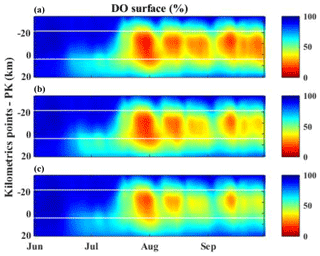
Figure 6Spatiotemporal evolution of daily average surface DO (saturation in %) along the tidal Garonne River section for the scenarios of reference (a), combining +10 m s−1 of river flow and reduction of 50 % of SO releases (b), and combining +10 m3 s−1 of river flow, a reduction of 50 % of SO releases and urban effluent discharges at KP15 (c). The y axis represents the kilometric points, and the white lines represent Bordeaux and Portets.
Regarding the projected population growth of the city of Bordeaux (1 million inhabitants will be reached in 2030, i.e. +33 %; http://www.bordeaux-metropole.fr, last access: 14 November 2019) and the objectives of the European Water Framework Directive to maintain good water quality, the reduction in the impact of urban wastewater networks in urban areas appears to be a major challenge for the coming years. The construction of an outfall under the river could be an efficient solution for totally mitigating hypoxia at Bordeaux, but this solution may be seen as an academic exercise considering its cost and technical constraints. Moreover, the environmental impact on the ecosystem of such construction can hinder this solution. The support of summer river flow could certainly be optimized by reducing water use for agricultural purposes in the watershed during summer and by improving the release of stored water as a function of meteorological conditions. In the case of unfavourable conditions (heat wave and drought) in early summer, LTS could be implemented. However, if these conditions occur late in summer, intense STS could be considered. An alternative solution could be intermittent support, with water release of 100 m3 s−1 during spring tide and all summer (July and August; i.e. four spring tides). By the continuation of the improvement in the urban wastewater network and by the simultaneously maintenance of good river flow levels, both management options may improve the oxygen level on the TGR.
A 3-D biogeochemical model for the tidal Garonne River coupling hydrodynamics and sediment transport was applied to assess the efficiency of different management solutions to improve the DO level in water. This study tested different scenarios of management solutions that can be implemented by local water authorities. Whereas a reduction in SO flows contributes only to improving DO levels locally and temporarily, the downstream relocation of WWTP outfalls totally mitigates hypoxia in the TGR and seems to be the most efficient management solution despite being difficult to implement in practice. The support of low river flow limits the propagation of the TMZ upstream of the TGR and dilutes the estuarine water with fresh oxygenated water. Low-intensity support over the summer maintains a good oxygen level of water during the entire drought period and prevents hypoxia in the upper TGR. In contrast, intense support of low water flow for 3 d improves the oxygen levels along the entire TGR quickly and considerably but only for a few weeks. The improvement in the urban effluent network and the support of low-water periods from dams or irrigation reduction are complementary. They contribute to reoxygenating the river water near the city of Bordeaux and upstream of the tidal Garonne River. The biogeochemical numerical model helps in guiding the management policy of urban effluents and watersheds to limit and mitigate hypoxia events.
References and/or websites of in situ data that we used for this work are mentioned throughout the text. The outputs of the different simulations are not stored in a publicly accessible database due to their large size. They are however available from the corresponding author upon request.
| DO | Dissolved oxygen |
| DOC | Dissolved organic carbon |
| LTS | Long-term support |
| POC | Particulate organic carbon |
| SO | Sewage overflow |
| STS | Short-term support |
| TGR | Tidal Garonne River |
| TMZ | Turbidity maximum zone |
| WWTP | Wastewater treatment plant |
KLS designed the model, analysed the data and wrote the paper. AS, GA and SS contributed to the design and implementation of the research, to the analysis of the results, and to the writing of the paper. XL and GB supervised the findings of this work.
The authors declare that they have no conflict of interest.
This study was funded by the Aquitaine region (DIAGIR project) and LyRE (SUEZ research centre), who cosponsored a PhD grant to Katixa Lajaunie-Salla, and was supported by the Cluster of Excellence COTE at the Université de Bordeaux (ANR-10-LABX-45). The authors are grateful to the MAGEST network for the availability of data and to the SGAC and Bordeaux Métropole for providing urban effluent data and for fruitful discussions. This work was supported by the Avakas cluster resources of the Mésocentre de Calcul Intensif Aquitain (MCIA) of the Université de Bordeaux.
This study was funded by the Aquitaine region (DIAGIR project) and LyRE (SUEZ research centre).
This paper was edited by Mauricio Gonzalez and reviewed by three anonymous referees.
Abril, G., Etcheber, H., Le Hir, P., Bassoullet, P., Boutier, B., and Frankignoulle, M.: Oxic/anoxic oscillations and organic carbon mineralization in an estuarine maximum turbidity zone (The Gironde, France), Limnol. Oceanogr., 44, 1304–1315, 1999.
Allen, G. P.: Étude des processus sédimentaires dans l'estuaire de la Gironde, Université de Bordeaux, Bordeaux, France, 1972.
Andréa, G., Ahyerre, M., Pérarnaud, M., Komorowski, F., and Schoorens, J.: Gestion Dynamique des RUTP du bassin versant Louis Fargue à Bordeaux: mise en oeuvre et premiers résultats opérationnels, NOVATECH 2013, Bordeaux, France, 2013.
Andrews, M. J. and Rickard, D. G.: Rehabilitation of the inner Thames estuary, Mar. Pollut. Bull., 11, 327–332, https://doi.org/10.1016/0025-326X(80)90051-X, 1980.
Best, M. A., Wither, A. W., and Coates, S.: Dissolved oxygen as a physico-chemical supporting element in the Water Framework Directive, Mar. Policy, 55, 53–64, https://doi.org/10.1016/j.marpolbul.2006.08.037, 2007.
Billen, G., Garnier, J., Ficht, A., and Cun, C.: Modeling the Response of Water Quality in the Seine River Estuary to Human Activity in its Watershed Over the Last 50 Years, Estuaries, 24, 977–993, https://doi.org/10.2307/1353011, 2001.
Billen, G., Garnier, J., and Rousseau, V.: Nutrient fluxes and water quality in the drainage network of the Scheldt basin over the last 50 years, Hydrobiologia, 540, 47–67, https://doi.org/10.1007/s10750-004-7103-1, 2005.
Breitburg, D., Levin, L. A., Oschlies, A., Grégoire, M., Chavez, F. P., Conley, D. J., Garçon, V., Gilbert, D., Gutiérrez, D., Isensee, K., Jacinto, G. S., Limburg, K. E., Montes, I., Naqvi, S. W. A., Pitcher, G. C., Rabalais, N. N., Roman, M. R., Rose, K. A., Seibel, B. A., Telszewski, M., Yasuhara, M., and Zhang, J.: Declining oxygen in the global ocean and coastal waters, Science, 359, eaam7240, https://doi.org/10.1126/science.aam7240, 2018.
Conley, D. J., Carstensen, J., Vaquer-Sunyer, R., and Duarte, C. M.: Ecosystem thresholds with hypoxia, Hydrobiologia, 629, 21–29, https://doi.org/10.1007/s10750-009-9764-2, 2009.
Diaz, R. J.: Overview of hypoxia around the world., J. Environ. Qual., 30, 275–281, https://doi.org/10.2134/jeq2001.302275x, 2001.
EPA: Real time control of urbain drainage networks, Office of Research and Development, Washington, USA, 2006.
Etcheber, H., Taillez, A., Abril, G., Garnier, J., Servais, P., Moatar, F., and Commarieu, M.-V.: Particulate organic carbon in the estuarine turbidity maxima of the Gironde, Loire and Seine estuaries: origin and lability, Hydrobiologia, 588, 245–259, https://doi.org/10.1007/s10750-007-0667-9, 2007.
Etcheber, H., Schmidt, S., Sottolichio, A., Maneux, E., Chabaux, G., Escalier, J.-M., Wennekes, H., Derriennic, H., Schmeltz, M., Quéméner, L., Repecaud, M., Woerther, P., and Castaing, P.: Monitoring water quality in estuarine environments: lessons from the MAGEST monitoring program in the Gironde fluvial-estuarine system, Hydrol. Earth Syst. Sci., 15, 831–840, https://doi.org/10.5194/hess-15-831-2011, 2011.
Even, S., Mouchel, J. M., Servais, P., Flipo, N., Poulin, M., Blanc, S., Chabanel, M., and Paffoni, C.: Modelling the impacts of Combined Sewer Overflows on the river Seine water quality, Sci. Total Environ., 375, 140–151, https://doi.org/10.1016/j.scitotenv.2006.12.007, 2007.
Gonwa, W. S. and Novotny, V.: Efficient Real Time Control and Operation of Interconnected Wastewater Collection Systems, Marquette University, Milwaukee, WI, USA, 395 pp., 1993.
Goosen, N. K., Kromkamp, J., Peene, J., van Rijswijk, P., and Breugel, P. van: Bacterial and phytoplankton production in the maximum turbidity zone of three European estuaries: the Elbe, Westerschelde and Gironde, J. Marine Syst., 22, 151–171, 1999.
Howarth, R. W., Swaney, D. P., Butler, T. J., and Marino, R.: Rapid Communication: Climatic Control on Eutrophication of the Hudson River Estuary, Ecosystems, 3, 210–215, https://doi.org/10.1007/s100210000020, 2000
Jalón-Rojas, I., Schmidt, S., and Sottolichio, A.: Turbidity in the fluvial Gironde Estuary (southwest France) based on 10-year continuous monitoring: sensitivity to hydrological conditions, Hydrol. Earth Syst. Sci., 19, 2805–2819, https://doi.org/10.5194/hess-19-2805-2015, 2015.
Kemp, W. M., Testa, J. M., Conley, D. J., Gilbert, D., and Hagy, J. D.: Temporal responses of coastal hypoxia to nutrient loading and physical controls, Biogeosciences, 6, 2985–3008, https://doi.org/10.5194/bg-6-2985-2009, 2009.
Lajaunie-Salla, K., Wild-Allen, K., Sottolichio, A., Thouvenin, B., Litrico, X., and Abril, G.: Impact of urban effluents on summer hypoxia in the highly turbid Gironde Estuary , applying a 3D model coupling hydrodynamics , sediment transport and biogeochemical processes, J. Marine Syst., 174, 89–105, https://doi.org/10.1016/j.jmarsys.2017.05.009, 2017.
Lajaunie-Salla, K., Sottolichio, A., Schmidt, S., Litrico, X., Binet, G., and Abril, G.: Future intensification of summer hypoxia in the tidal Garonne River (SW France) simulated by a coupled hydro sedimentary-biogeochemical model, Environ. Sci. Pollut. R., 25, 31957–31970, https://doi.org/10.1007/s11356-018-3035-6, 2018.
Lanoux, A.: Caratérisation et rôle respectif des apports organiques amont et locaux sur l'oxygènation des eaux de la Garonne estuarienne, Université de Bordeaux, Bordeaux, France, 2013.
Lanoux, A., Etcheber, H., Schmidt, S., Sottolichio, A., Chabaud, G., Richard, M., and Abril, G.: Factors contributing to hypoxia in a highly turbid, macrotidal estuary (the Gironde, France), Environ. Sci. Process. Impacts, 15, 585–595, https://doi.org/10.1039/c2em30874f, 2013.
Lehmann, A., Hinrichsen, H. H., Getzlaff, K., and Myrberg, K.: Quantifying the heterogeneity of hypoxic and anoxic areas in the Baltic Sea by a simplified coupled hydrodynamic-oxygen consumption model approach, J. Marine Syst., 134, 20–28, https://doi.org/10.1016/j.jmarsys.2014.02.012, 2014.
Lemaire, E.: Biomarqueurs pigmentaires dans les estuaires macrotidaux européens, Ec. Dr. des Sci. du vivant, géosciences Sci. l'environnement, Doctorat, Université de Bordeaux, Bordeaux, France, 236, 2002.
Lemaire, E., Abril, G., De Wit, R., and Etcheber, H.: Effet de la turbidité sur la dégradation des pigments phytoplanctoniques dans l'estuaire de la Gironde, Geoscience, 334, 251–258, 2002.
Maeda, M., Mizushima, H., and Ito, K.: Development of the Real-Time Control (RTC) System for Tokyo Sewage System, Water Sci. Technol., 51, 213–220, https://doi.org/10.2166/wst.2005.0050, 2005.
Pleau, M., Colas, H., Lavallée, P., Pelletier, G., and Bonin, R.: Global optimal real-time control of the Quebec urban drainage system, Environ. Modell. Softw., 20, 401–413, https://doi.org/10.1016/j.envsoft.2004.02.009, 2005.
Rabalais, N. N., Díaz, R. J., Levin, L. A., Turner, R. E., Gilbert, D., and Zhang, J.: Dynamics and distribution of natural and human-caused hypoxia, Biogeosciences, 7, 585–619, https://doi.org/10.5194/bg-7-585-2010, 2010.
Robitaille, L., Komorowski, F., Fortier, V., Chadoutaud, E., and Rousseau, J.-P.: Gestion Dynamique des RUTP du bassin versant Louis Fargue à Bordeaux: en route vers une seconde phase de déploiement, NOVATECH 2016, Bordeaux, France, 2016.
Schmidt, S., Bernard, C., Escalier, J.-M., Etcheber, H., and Lamouroux, M.: Assessing and managing the risks of hypoxia in transitional waters: a case study in the tidal Garonne River (South-West France), Environ. Sci. Pollut. R., 24, 3251–3259, https://doi.org/10.1007/s11356-016-7654-5, 2017.
Skerratt, J., Wild-Allen, K., Rizwi, F., Whitehead, J., and Coughanowr, C.: Use of a high resolution 3D fully coupled hydrodynamic, sediment and biogeochemical model to understand estuarine nutrient dynamics under various water quality scenarios, Ocean Coast. Manag., 83, 52–66, https://doi.org/10.1016/j.ocecoaman.2013.05.005, 2013.
Soetaert, K., Middelburg, J. J., Heip, C., Meire, P., Van, S., Maris, T., and Damme, S. Van: Long-term change in dissolved inorganic nutrients in the heterotrophic Scheldt estuary (Belgium, The Netherlands), Limnol. Oceanogr., 51, 409–423, 2006.
Sottolichio, A., Le Hir, P., and Castaing, P.: Modeling mechanisms for the stability of the turbidity maximum in the Gironde estuary, France, Proc. Mar. Sci., 3, 373–386, https://doi.org/10.1016/S1568-2692(00)80132-1, 2000.
Talke, S. A., Swart, H. E., and de Jonge, V. N.: An Idealized Model and Systematic Process Study of Oxygen Depletion in Highly Turbid Estuaries, Estuar. Coast., 32, 602–620, https://doi.org/10.1007/s12237-009-9171-y, 2009.
Tinsley, D.: The Thames estuary: a history of the impact of humans on the environment and a description of the current approach to environmental management, in: A Rehabilitated Estuarine Ecosystem SE – 2, edited by: Attrill, M., 5–26, Springer US, Plymouth University, Plymouth, UK, 1998.
Vanderborght, J.-P., Folmer, I. M., Aguilera, D. R., Uhrenholdt, T., and Regnier, P.: Reactive-transport modelling of C, N, and O2 in a river–estuarine–coastal zone system: Application to the Scheldt estuary, Mar. Chem., 106, 92–110, https://doi.org/10.1016/j.marchem.2006.06.006, 2007.
Vaquer-Sunyer, R. and Duarte, C. M.: Thresholds of hypoxia for marine biodiversity, P. Natl. Acad. Sci. USA, 105, 15452–15457, https://doi.org/10.1073/pnas.0803833105, 2008.
Veyssy, E.: Transferts de matière organiques das bassins versants aux estuaires de la Gironde et de l'Adour (Sud-Ouest de la France), Université de Bordeaux, Bordeaux, France, 1998.
Willmott, C. J.: Some comments on the evaluation of model performance, B. Am. Meteorol. Soc., 63, 1309–1313, https://doi.org/10.1175/1520-0477(1982)063<1309:SCOTEO>2.0.CO;2, 1982.
Zhang, P., Pang, Y., Pan, H., Shi, C., Huang, Y., and Wang, J.: Factors Contributing to Hypoxia in the Minjiang River Estuary, Southeast China, Int. J. Env. Res. Pub. He., 12, 9357–9374, https://doi.org/10.3390/ijerph120809357, 2015.






